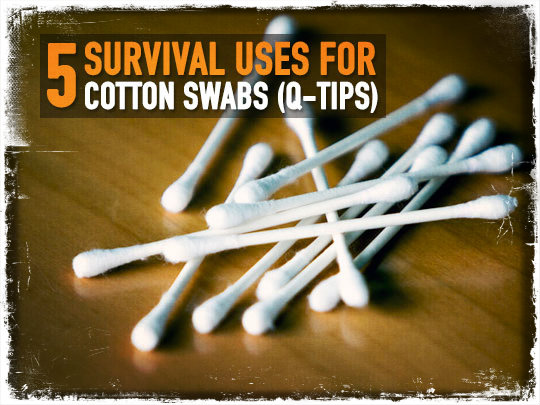
For cleaning your ear canals right, well doctors do not recommend you put anything smaller than your elbow in your ear. Q-tips and ear canals do not mix well, because you can rupture your eardrum, and besides, ear wax plays an important role in protecting your ears. Why do they have two ends then, for two ears right.
There are various types of cotton swabs, one with wooden rods, and those with short plastic rods. Medical ones typically have the cotton swabs attached to a wooden dowel, and these do come packaged sterile, and they are considerably longer than swabs that are normally found in home medicine cabinets. Then you have cotton swabs designed to be used in model making and those specifically for cosmetic applications.
Others Uses for Q-Tips besides Sticking In Your Ears
1.) Fire Making
Cotton is combustible of course, and so a cotton swab is a match in a sense, but it needs an ignition source. Light the swab and use to start dry tinder instead of trying to reach under the bundle with a lighter or match, which usually results in you burning your fingers before the tinder ignites. The swab will burn considerably longer than a wooden match will. The plastic rod will burn as well, and the flaming plastic can be “dripped” to ignite combustibles.
Bundle 4 to 6 swabs together using duct tape or cordage. This gives you a sizable surface to work with. Dip one or both ends in warmed pine resin a number of times to collect a ball of resin. Let the ball dry, now you have a match that can be used in virtually any weather to start a fire using damp combustibles. The resin will burn similar to candle wax, and can be used as a makeshift candle if you secure it upright. Remember, the plastic rods will burn, and they may give off toxic fumes.
Bundle the swabs together, fluff the cotton ends and shave a magnesium bar over the cotton. Once the cotton is well sprinkled with magnesium dip in petroleum jelly and seal in a baggie or otherwise protect from moisture.
2.) Applications
Dip a swab in paraffin to apply to any seam for waterproofing. Do not discard the used swab, save it for later to light your fire.
Dip a swab in water and then sprinkle some baking soda over it to brush your teeth. Use this same method to clean/scrub hard to reach places on gear and equipment.
Use pines resin to waterproof seams by warming a piece of the resin up, and then use a swab to apply to boot/shoe seams, tent seams or to gear.
3.) Firearms Maintenance
Swabs are ideal for cleaning those hard to reach places. Patches that are typically used do not always fit into tight places when attached to the cleaning rod. In a field environment you can bundle several together to “swab” out your barrel. Put some solvent on the ends and run through the barrel a few times. In some cases you may have to attach the swabs to a rod for longer barrels. The wooden swabs are ideal for this.
Obviously, a bore brush will remove the fouling better, but in an emergency you can remove some of the residue with this method.
4.) Medical
Ever get a piece of grit or even a bug in your eye. Those little gnats are everywhere. Dip a cotton swab in some clean water or use dry and then touch to the foreign object in your eye to remove. Make sure your hands are clean and any water you use is clean.
Use a swab to apply ointments in hard to reach places, and by applying a small amount to the swab you will use less. A big dab on the finger to rub around the cut or wound is usually more than needed.
Use as a dropper to measure bleach or iodine for water purification. Dip the cotton tip in bleach or iodine and allow the solution to form a drop. Bleach and iodine are commonly measured in drops for water purification.
5.) Sandpaper
Use a single swab for small areas or bundle together for larger areas. Wet the cotton tip and dip in sand and scrub away on surfaces. You can also place wet sand on the surface to be scrubbed without dipping the swab in the sand.
Stone was thought to have been cut thousands of years ago using sand, water, and cordage.
You will leave sand behind so be careful you do not use this method on firearms or where sand would cause moving parts to stop working. Use to rough up surfaces so they can be glued together, use to subdue shiny objects to cut down on reflections in a field environment, or use to polish certain surfaces such as wood, metal or stone.
You can use sand and cotton swabs to clean mess kits of food residue. Sand has been used for centuries to scrub cookware and to shape wood and stone.